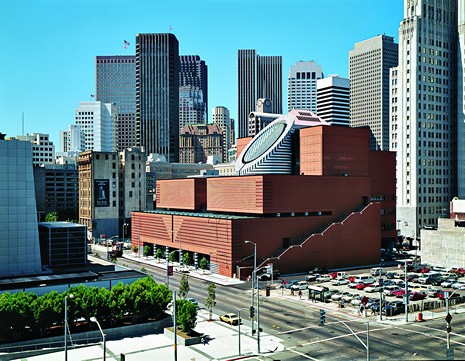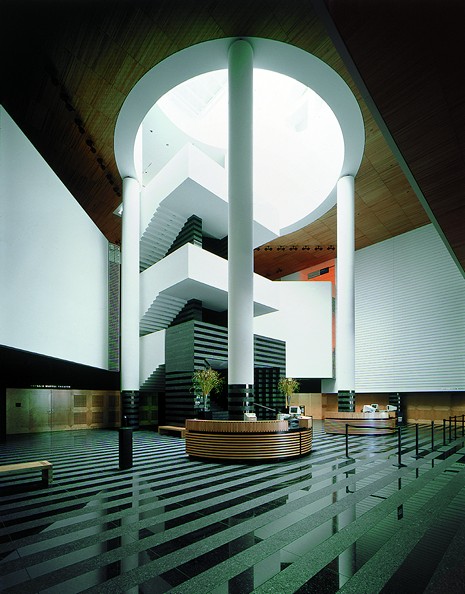Description
The urban planning objective for the building that houses the San Francisco Museum of Modern Art was to mediate between a skyscraper canyon and a park with low perimeter development. In addition, the building was to be an important part of an urban revitalization project. Mario Botta, for whom this brief awarded in 1989 was his first in the United States, resolved the problem with a symmetrically composed building of stepped-back blocks stacked on top of each other, its centre formed by a diagonally capped cylinder. The black and silver-grey granite stripes on this cylindrical tower present a striking contrast to the red bricks that are not simply the cladding for the rest of the building (362 different brick sizes were used) but instead subtly structure the surfaces of its stereometrically clear volumes and intensify the effect of plasticity. The brick façades, absolutely atypical for San Francisco, and their windowlessness point to this building’s special meaning; indeed, it houses one of the most important collections of contemporary art on the west coast of the United States.
The dominant cylinder forms the centre of the museum in every respect. Its slant is not motivated just by urban planning concerns, but also and to the same extent by lighting technology and not least, iconology (it has been called a “seeing eye”). It is from there that the light falls through all the levels of the building into the atrium (whose design is highly stylized, possibly too consistently) from which more than just the ground floor (with auditorium, multiple-use event space, seminar room, museum shop, cafe, etc.) is accessed. All the gallery levels above it can be accessed from it as well, via a staircase placed like a sculpture in this beam of light. Circulation through the galleries has been designed so that visitors always return to this centre point. The staggered stacking of the building volumes enables the majority of the galleries (with the sole exception of the second storey intended for the presentation of the photo collection), of varying heights and distributed over four storeys, to be naturally lighted via skylights whose form reminds one a little of the Kimbell Art Museum by Louis Kahn, one of Mario Botta’s important teachers.
Pippo Ciorra, Botta, Eisenman, Gregotti, Hollein: musei, Milan, 1991, pp. 39-64 • Museo d’arte e architettura, exhibition catalogue, Lugano, 1992, pp. 150-155 • The Making of a Modern Museum. San Francisco Museum of Modern Art, San Francisco, 1994 • achitektur aktuell 173-174/1994, pp. 54-61 (Georg Schrom) • Lotus international 86/1995, pp. 6-26 (Janet Abrams) • Francisco Asensio Cerver, The Architecture of Museums, New York, 1997, pp. 20-31 • Emilio Pizzi, Mario Botta, Basel/Berlin/Boston, 1998, pp. 174-177 • Justin Henderson, Museum Architecture, London, 1998, pp. 46-53 • Victoria Newhouse, Towards a New Museum, New York, 1998, pp. 61-65 • Vittorio Magnago Lampugnani/Angeli Sachs (eds.), Museums for a New Millennium, Munich/London/New York, 1999, pp. 76-83 (Kenneth Frampton) • Justin Henderson, San Francisco Museum of Modern Art, San Francisco, 2000
Drawings
Ground floor
Second floor
Fourth floor
Cross section
Longitudinal section
Photos

Exterior view

View of atrium from entance level
Originally published in: Paul von Naredi-Rainer, Museum Buildings: A Design Manual, Birkhäuser, 2004.